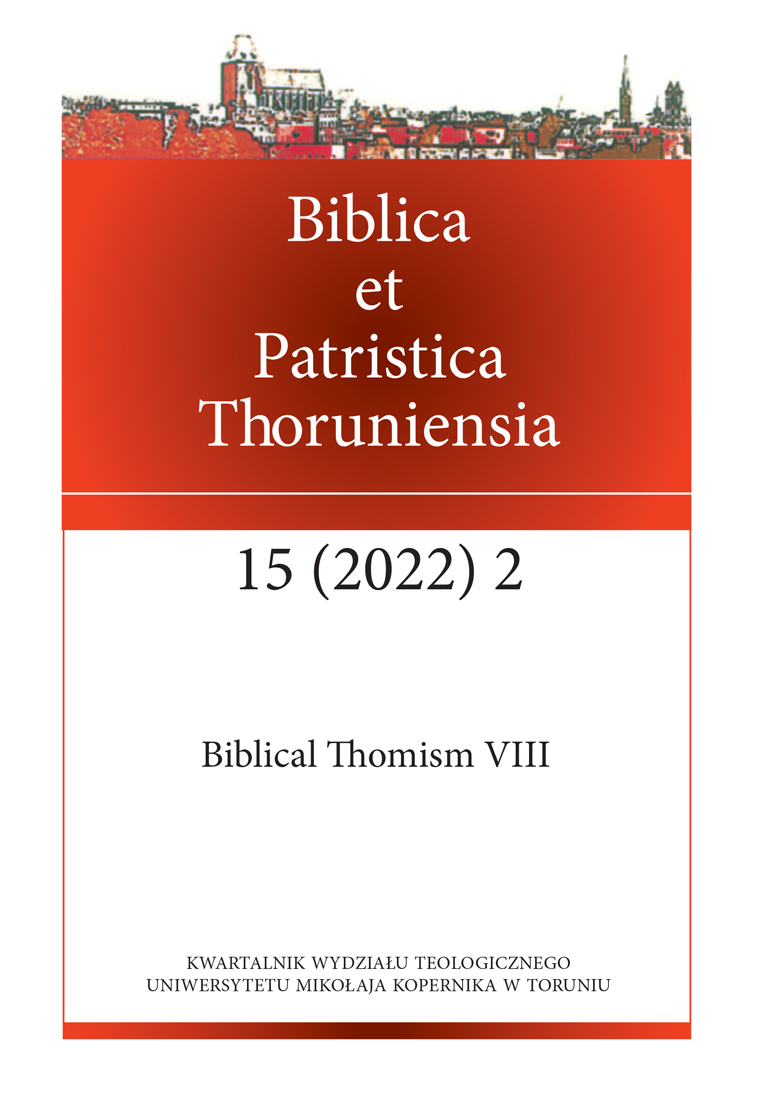De scripturis et scriptoribus sacris Hugona ze św. Wiktora. Wprowadzenie i przekład
DOI:
https://doi.org/10.12775/BPTh.2022.011Słowa kluczowe
Hugon ze św. Wiktora, alegoria, egzegeza, historia, Pismo ŚwięteAbstrakt
Niniejszy artykuł zawiera pierwszy przekład na język polski dzieła De scripturis et scriptoribus sacris Hugona ze św. Wiktora (zm. 1141), które stanowi wartościowy przykład scholastycznej introdukcji biblijnej. W tekście tym Hugon dostarcza przydatnych wskazówek, które pozwalają właściwie czytać, rozumieć i interpretować Pismo Święte. Cechą charakterystyczną dzieła jest mocny akcent położony na historyczne rozumienie tekstów natchnionych. Traktat zawiera osiemnaście rozdziałów, w których można wyróżnić następujące cztery zasadnicze grupy tematyczne: kryteria odróżniania pism natchnionych od pozostałych pism, kwestie związane z kanonicznością tekstów biblijnych, walor użyteczności Biblii oraz przedmiot materialny Pisma Świętego. Dzieło stanowi cenne źródło dla historii egzegezy biblijnej w średniowieczu i dostarcza praktycznych instrukcji egzegetycznych niezbędnych dla owocnej lektury Biblii aktualnych również dziś.
Bibliografia
Augustyn z Hippony. 1980. “De Genesi ad litteram libri duodecim”. Patrologia Latina. J.P. Migne (ed.) 34, kol. 246–486. Komentarz słowny do Księgi Rodzaju. Pisma egzegetyczne przeciw manichejczykom. Przekł. J. Sulowski, 113–382. Warszawa: Akademia Teologii Katolickiej.
Hieronim ze Strydonu. 1969. Praefatio in Pentateuchum. Biblia Sacra iuxta Vulgatam Versionem. Edited by R. Weber. 1:3–4; Patrologia Latina 28, kol. 147–152. Stuttgart.
Hieronim ze Strydonu. O nazwach hebrajskich. Patrologia Latina 23, kol. 839A.
Hugon ze św. Wiktora. De scripturis et scriptoribus sacris. Patrologia Latina 175, kol. 9A–28D.
Hugon ze św. Wiktora. De sacramentis christianae fidei. Patrologia Latina 176, kol. 173A–618B.
Hugon ze św. Wiktora. 2017. Didascalicon, czyli co i jak czytać, przekład z języka łacińskiego. P. Pludra-Żuk, Warszawa : Instytut Badań Literackich PAN.
Hugh of St.-Victor. 2012. “On sacred scripture and its authors”, przekł. F. van Liere. In F.T Harkins, F. van Liere (ed.). Interpretation of Scripture, Theory, A selection of Works of Hugh, Andrew, Richard and Godfrey of St. Victor and of Robert of Melun, VTT, s. 213–230. Turnhout: Brepols Publishers Victorine Texts.
Hugon ze św. Wiktora. 1966. “Epitome Dindimi”, Hugo de Sancto Victore. Opera propaedeutica, edited by R. Baron, 187–247. Notre Dame.
Hugon ze św. Wiktora. Manuskrypt. Bibliothèque nationale de France, lat. 2092, f. 65v–77r. Paris.
Izydor z Sewilli. 1911. Etymologiarum sive originum libri XX, W. M. Lindsay (ed.). Oxford.
Izydor z Sewilli. Quaestiones in Vetus Testamentum. PL 83, kol. 207–423.
Pismo Święte Starego i Nowego Testamentu. 2003. Wyd. IV. Poznań: Pallottinum.
Berndt, Rainer 1988. “«Gehören die Kirchenväter zur Heiligen Schrift?», Zur Kanontheorie des Hugo von Sankt Viktor.” In: Zum Problemdes biblischen Kanons, edited by I. Baldermann et al., 191–199. Neukirchen-Vluyn.
Croydon F. E. 1939. “Notes on the life of Hugh of st. Victor.” The Journal of Theological Studies 40 (159): 232–253.
Delègue, Yves. 1987. Les machines du sens: fragments d’une sémiologie médiévale. Textes de Hugues de Saint-Victor, Thomas d’Aquin et Nicolas de Lyre, Paris.
Graboïs, Aryeh. 1975. “The Hebraica Veritas and Jewish-Christian Intellectual Relations in the Twelfth Century.” Speculum 50: 613–634.
Janeczek, Stanisław. 2003. „Hugon ze św. Wiktora”. W Powszechna Encyklopedia Filozofii, t. 4, 620–622. Lublin: Polskie Towarzystwo Tomasza z Akwinu.
Maciąg, Agnieszka. 2011. „Jaki pożytek płynie z czytania? Kwestia utilitas w średniowiecznych accessus ad auctores.” Terminus 13 (24): 31–40.
Majewski, Marcin. 2013. Jak przekłady zmieniają sens Biblii… O teorii i praktyce tłumaczenia Biblii. Kraków.
Majewski, Marcin. 2012. „Wyrocznia efodu oraz urim i tummim w Biblii Hebrajskiej”. Scripta Biblica et Orientalia 4: 91–107.
Poirel, Dominique. 2002. “L’opuscule «Praesens saeculum»: un texte inédit de Hugues de Saint-Victor sur l’histoire sainte.” W Dominique Poirel, Livre de la Nature et d.bat trinitaire au XIIe siècle. Le “De tribus diebus” de Hugues de Saint-Victor, Bibliotheca Victorina 14, 446–451. Turnhout: Brepols.
Rorem, Paul. 2009. Hugh of saint Victor. Oxford: University Press.
Roszak, Piotr. 2018. “Rola Pisma Świętego w średniowiecznej teologii.” Teologia w Polsce 12 (2): 71–84.
Sicard, Patrice. 1991. Hugues de Saint-Victor et son école. Turnhout: Brepols.
Słownik biblijny, https://biblia.wiara.pl/slownik/67ea4.Slownikbiblijny/slowo/SYNAGOGA (dostęp 23.02.2022).
Smalley, Beryl. 1952. The study of the Bible in the Middle Ages. Oxford: Blackwell.
Soszyński, Jacek. 2017. „Wstęp.” W Hugon ze św. Wiktora, Didascalicon, czyli co i jak czytać, przekład z języka łacińskiego P. Pludra-Żuk, 9–46. Warszawa: Instytut Badań Literackich PAN.
Van Liere, Frans. 2012. “Introduction to On Sacred Scripture and Its Authors and The Diligent Examiner.” In Interpretation of Scripture, Theory, A selection of Works of Hugh, Andrew, Richard and Godfrey of St. Victor and of Robert of Melun, edited by F.T Harkins, F. van Liere, 205–211. Turnhout: VTT 3.
Zawadzki, Robert K. 1996. „Poetyka Arystotelesa i Sztuka Poetycka Horacego.” W Studium porównawcze, Częstochowa: WSP Częstochowa.
Zinn, Grover A. 1997. “Hugh of st. Victor’s De scripturis et scriptoribus sacris as an „accessus” treatise for the study of the Bible.” Traditio 52: 111–134.
Pobrania
Opublikowane
Jak cytować
Numer
Dział
Licencja

Utwór dostępny jest na licencji Creative Commons Uznanie autorstwa – Bez utworów zależnych 4.0 Międzynarodowe.
CC BY ND 4.0. Posiadaczem prawa autorskiego (Licencjodawcą) jest Autor, który na mocy umowy licencyjnej udziela nieodpłatnie prawa do eksploatacji dzieła na polach wskazanych w umowie.
- Licencjodawca udziela Licencjobiorcy licencji niewyłącznej na korzystanie z Utworu/przedmiotu prawa pokrewnego w następujących polach eksploatacji: a) utrwalanie Utworu/przedmiotu prawa pokrewnego; b) reprodukowanie (zwielokrotnienie) Utworu/przedmiotu prawa pokrewnego drukiem i techniką cyfrową (e-book, audiobook); c) wprowadzania do obrotu egzemplarzy zwielokrotnionego Utworu/przedmiotu prawa pokrewnego; d) wprowadzenie Utworu/przedmiotu prawa pokrewnego do pamięci komputera; e) rozpowszechnianie utworu w wersji elektronicznej w formule open access na licencji Creative Commons (CC BY-ND 3.0) poprzez platformę cyfrową Wydawnictwa Naukowego UMK oraz repozytorium UMK.
- Korzystanie przez Licencjobiorcę z utrwalonego Utworu ww. polach nie jest ograniczone czasowo ilościowo i terytorialnie.
- Licencjodawca udziela Licencjobiorcy licencji do Utworu/przedmiotu prawa pokrewnego nieodpłatnie na czas nieokreślony
PEŁEN TEKST UMOWY LICENCYJNEJ >>
Statystyki
Liczba wyświetleń i pobrań: 757
Liczba cytowań: 0



